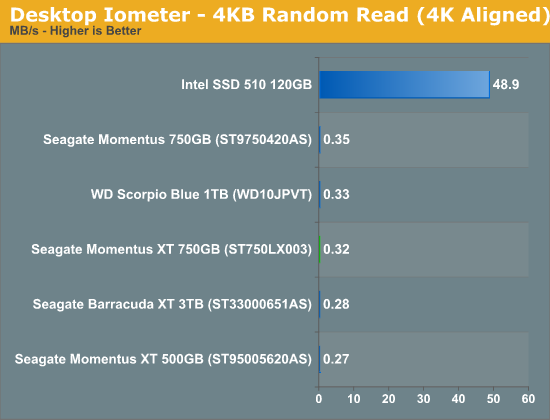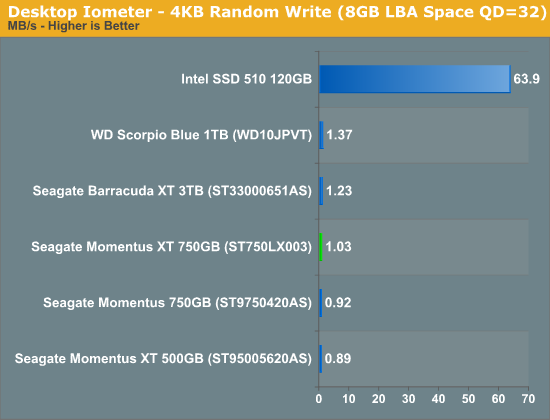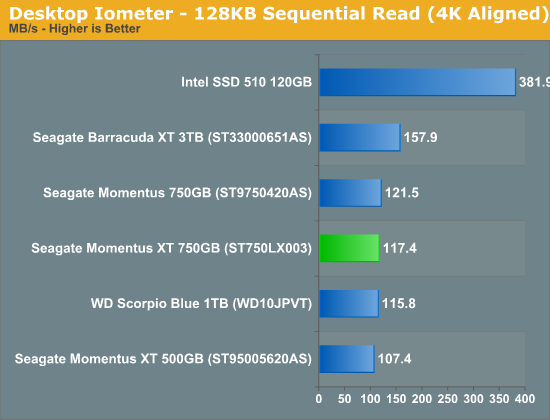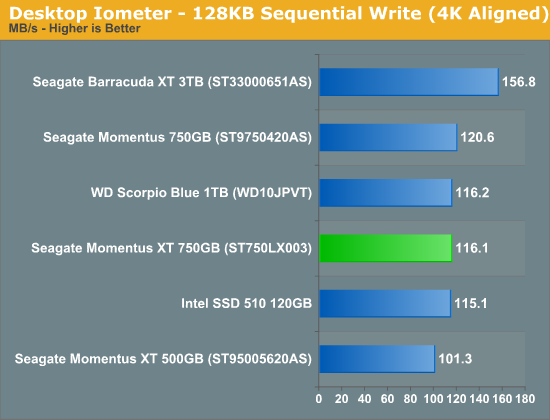Seagate 2nd Generation Momentus XT (750GB) Hybrid HDD Review
by Anand Lal Shimpi on December 13, 2011 12:51 AM EST- Posted in
- Storage
- Seagate
- Momentus XT
- Hybrid Drive
- HDDs
- SSHDs
Desktop Iometer Performance
Our raw Iometer tests don't really give the Momentus XT's NAND cache much of a chance to do anything. Random and sequential performance are both average compared to the hard drives we have here. In the case of uncached random access performance the Momentus XT performs no differently than a standard 7200 RPM 2.5" drive, which is to say not very well. This is arguably the biggest reason to go with an SSD if you can. Although the Momentus XT does amazingly well with relatively little NAND, anything that falls out of that 8GB cache is accessed very slowly compared to an SSD where the experience is more consistent.














98 Comments
View All Comments
murakozi - Tuesday, December 13, 2011 - link
I surely hope this iteration of Momentus XT is better than the original. I have had my share of the "performance" of that.Scenario: trying to migrate a WinXP system on a HP6910p from 2,5HDD to Momentus XT. Methods: Arconis, Norton Ghost, complete reinstall.
Result: epic failure. at first boot: sunshine and happyness. Than: BSOD, BSOD, non system disk..., NTFS failure, worse at every restart. Some digging in forums revealed serious issues with some SATA chipsets (note: this is a mainstream notebook, bot some nieche product).
Tried to reuse the drive in a desktop (Dell Optiplex 775), results: the same. A weekend of trial and error, resulting in error.
RMA-d the drive, got a Sandforce SSD instead (128 GB, for additional payment of course), living happily since then.
fuzzymath10 - Tuesday, December 13, 2011 - link
I migrated a Dell D630 from an 80GB X25-M (running out of space) to a 500GB Momentus XT and it worked perfectly on the first try, and has been working ever since.Despite the user not being of the "power" type, the drive has held up well, and I was impressed by how fast it felt in use despite the mess of applications running/installed.
Xajel - Tuesday, December 13, 2011 - link
In Notebooks, some guys need fast hard drive like an SSD but they still need bigger storage space... but the lake of space stops them.. they can't go for desktop like configuration ( SSD for OS, normal HDD for storage & media ) coz of lake of space and slots and weight also...Hybrid thought to be nice and better than regular HDD's but still very far from being SSD class performance...
I'm wondering why not separating the SSD part from the regular HDD part from this hybrid and use a SATA port multiplier to use the single SATA port with two drives but in one physical package... the drive will be normal, like a single platter 500GB drive but will have a port multiplier and an 128GB SSD within the drive... the drive will looks like 2 separated drives to the OS...
we can use SATA 6Gbps and split the bandwidth to 3+3 and still have plenty of bandwidth !!
the concept will be nice but expensive ( SSD + port duplicator + HDD in one package ) but it can do what Hybrids can't...
The only method to do such configuration is to use miniPCIe SSD drives on the laptop along with the regular HDD... but this will be limited to larger size of laptops as some smaller one does't have miniPCIe slot, or have but used by WiFi/Bluetooth module...
DanNeely - Tuesday, December 13, 2011 - link
Physical space constraints most likely, 2.5" HDs don't really have any extra volume to spare. You'd probably need to fall back on 1.8" platters meaning anything not in the SSD would take a large performance hit.freezervv - Tuesday, December 13, 2011 - link
This article is pretty amazing. ;)1) A nice reference to a general form of Amdahl's law
2) Useful "These are how the industry tenets / trends intersect in this product" summary in the video
3) Super sexy mic
4) Lost in Translation quote
As was noted in the article -- this drive isn't as fast as SSDs / high-density disks. Which is to say it's for products that a) require more space than SSDs can cost-effectively provide (so > 120GB) & b) can't physically accommodate 3.5" drives (or arrays thereof).
That's a not insignificant market -- virtually every laptop sold.
--------------------------------------------------------------------------------------
One big question, though, re: moving hybrid technology into the 3.5" form factor:
-- How do you see large, cheap NAND cache being reasonably deployed in the next decade?
From memory, we've currently got the following solutions...
-- Convention HDD buffers (e.g. 64MB)
-- Hybrid drives (similar, except with enough NAND capacity to do heavy predictive caching)
-- Intel Z68-style SRT (SSD in front of a disk array, tied in with chipset)
-- ZFS-style L2ARC / ZIL (same, except via the filesystem)
-- "Install OS to SSD, everything else to HDD" approach
-- Windows 7 SuperFetch
... which all add "memory" between RAM and the disk subsystem. And furthermore, which all try to pretend they're just "faster disk".
The issue, being illustrated by the following pathological (but not completely unreasonable) example:
-- Windows 7, running full SuperFetch
-- in an Intel Z68 SRT system
-- backed by hybrid SSHDDs
Assuming they're all running the same algorithm (or at least a similar one: some mix of locality, frequency, stride pattern, etc.) you could have Win7 caching an address in RAM, Intel caching the same thing to the SSD, and the hybrid drive caching the same thing in its NAND.
Which seems... ... ... "suboptimal"?
freezervv - Tuesday, December 13, 2011 - link
Or I guess, to put it another way, the same problem the IETF people are running into where TCP and large buffers lead to less-than-possible bandwidth.How do you design an oblivious (because we have to support legacy OSs), but still optimal (because we want performance) algorithm when the parts above and below you are in constant flux?
nicwillemse - Tuesday, December 13, 2011 - link
Hi Anand,Thanks for the review! Im currently using the previous verion in my mac with no issues what so ever, do you think I would have problems if I upgraded to the new one ?
poohbear - Tuesday, December 13, 2011 - link
Is this drive $245 due to the Thailand flooding and hdd shortage issue? I can't imagine paying $245 for 750gb HDD & a measly 8gb SSD.Stahn Aileron - Tuesday, December 13, 2011 - link
So I'm guessing with this push for NAND-based storage, we'll start seeing a bigger push for a DRAM Buffer/NAND Cache/Platter Storage scheme versus the current Buffer/Storage scheme?Even Intel is kinda pushing it with their SRT feature on select chipsets.
Anand, do you think we'll see more adoption of this type of technology at the system level (like Intel SRT) or more at the integrated device level (like the Momentus XT here)? Or maybe even integrated at the Motherboard level, perhaps? I don't really it happening at the MB level, since the onus would be on the MB manufacturers to support and validate it.
Also, any thoughts on the future about pure Flash storage versus magnetic storage? We're seeing these enterprise-grade, TB-sized drive available. Do you think hybrid schemes like the Momentus XT or Intel's SRT will make in-roads in that market? I'm curious about the future of storage and whether or not we'll all slowly move to viable all-flash storage mass solutions as flash memory costs drop. This barring any major advance in other longterm storage technologies, like holographic systems.
freezervv - Tuesday, December 13, 2011 - link
Check comments page 2. ;)It really does beg the question...